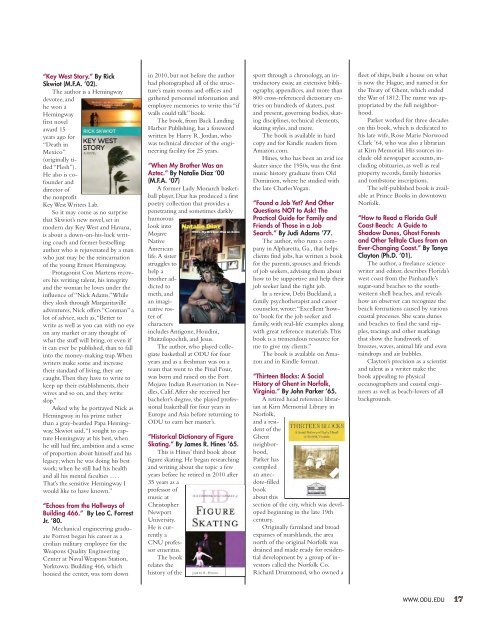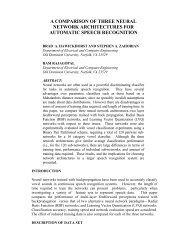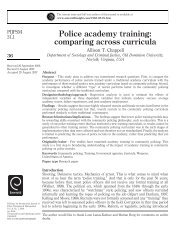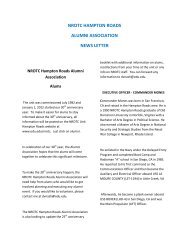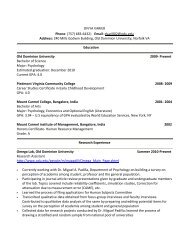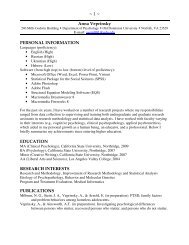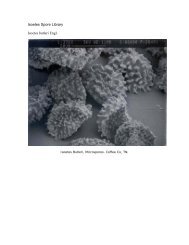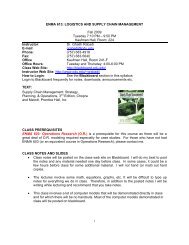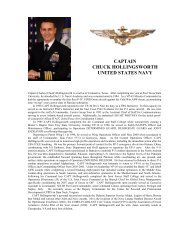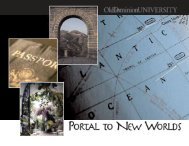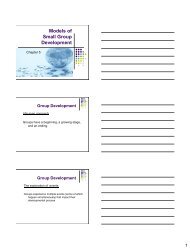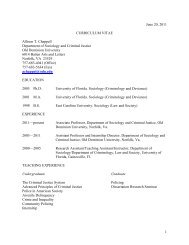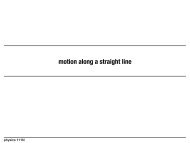Payoff Season for Fifth- Year Seniors - Old Dominion University
Payoff Season for Fifth- Year Seniors - Old Dominion University
Payoff Season for Fifth- Year Seniors - Old Dominion University
You also want an ePaper? Increase the reach of your titles
YUMPU automatically turns print PDFs into web optimized ePapers that Google loves.
“Key West Story.” By Rick<br />
Skwiot (M.F.A. ’02).<br />
The author is a Hemingway<br />
devotee, and<br />
he won a<br />
Hemingway<br />
first novel<br />
award 15<br />
years ago <strong>for</strong><br />
“Death in<br />
Mexico”<br />
(originally titled<br />
“Flesh”).<br />
He also is cofounder<br />
and<br />
director of<br />
the nonprofit<br />
Key West Writers Lab.<br />
So it may come as no surprise<br />
that Skwiot’s new novel, set in<br />
modern day Key West and Havana,<br />
is about a down-on-his-luck writing<br />
coach and <strong>for</strong>mer bestselling<br />
author who is rejuvenated by a man<br />
who just may be the reincarnation<br />
of the young Ernest Hemingway.<br />
Protagonist Con Martens recovers<br />
his writing talent, his integrity<br />
and the woman he loves under the<br />
influence of “Nick Adams.” While<br />
they slosh through Margaritaville<br />
adventures, Nick offers “Conman” a<br />
lot of advice, such as, “Better to<br />
write as well as you can with no eye<br />
on any market or any thought of<br />
what the stuff will bring, or even if<br />
it can ever be published, than to fall<br />
into the money-making trap. When<br />
writers make some and increase<br />
their standard of living, they are<br />
caught. Then they have to write to<br />
keep up their establishments, their<br />
wives and so on, and they write<br />
slop.”<br />
Asked why he portrayed Nick as<br />
Hemingway in his prime rather<br />
than a gray-bearded Papa Hemingway,<br />
Skwiot said, “I sought to capture<br />
Hemingway at his best, when<br />
he still had fire, ambition and a sense<br />
of proportion about himself and his<br />
legacy; when he was doing his best<br />
work; when he still had his health<br />
and all his mental faculties … .<br />
That’s the sensitive Hemingway I<br />
would like to have known.”<br />
“Echoes from the Hallways of<br />
Building 466.” By Leo C. Forrest<br />
Jr. ’80.<br />
Mechanical engineering graduate<br />
Forrest began his career as a<br />
civilian military employee <strong>for</strong> the<br />
Weapons Quality Engineering<br />
Center at Naval Weapons Station,<br />
Yorktown. Building 466, which<br />
housed the center, was torn down<br />
in 2010, but not be<strong>for</strong>e the author<br />
had photographed all of the structure’s<br />
main rooms and offices and<br />
gathered personnel in<strong>for</strong>mation and<br />
employee memories to write this “if<br />
walls could talk” book.<br />
The book, from Back Landing<br />
Harbor Publishing, has a <strong>for</strong>eword<br />
written by Harry R. Jordan, who<br />
was technical director of the engineering<br />
facility <strong>for</strong> 25 years.<br />
“When My Brother Was an<br />
Aztec.” By Natalie Diaz ‘00<br />
(M.F.A. ‘07)<br />
A <strong>for</strong>mer Lady Monarch basketball<br />
player, Diaz has produced a first<br />
poetry collection that provides a<br />
penetrating and sometimes darkly<br />
humorous<br />
look into<br />
Mojave<br />
Native<br />
American<br />
life. A sister<br />
struggles to<br />
help a<br />
brother addicted<br />
to<br />
meth, and<br />
an imaginativeroster<br />
of<br />
characters<br />
includes Antigone, Houdini,<br />
Huitzilopochtli, and Jesus.<br />
The author, who played collegiate<br />
basketball at ODU <strong>for</strong> four<br />
years and as a freshman was on a<br />
team that went to the Final Four,<br />
was born and raised on the Fort<br />
Mojave Indian Reservation in Needles,<br />
Calif. After she received her<br />
bachelor’s degree, she played professional<br />
basketball <strong>for</strong> four years in<br />
Europe and Asia be<strong>for</strong>e returning to<br />
ODU to earn her master’s.<br />
“Historical Dictionary of Figure<br />
Skating.” By James R. Hines ’65.<br />
This is Hines’ third book about<br />
figure skating. He began researching<br />
and writing about the topic a few<br />
years be<strong>for</strong>e he retired in 2010 after<br />
35 years as a<br />
professor of<br />
music at<br />
Christopher<br />
Newport<br />
<strong>University</strong>.<br />
He is currently<br />
a<br />
CNU professor<br />
emeritus.<br />
The book<br />
relates the<br />
history of the<br />
sport through a chronology, an introductory<br />
essay, an extensive bibliography,<br />
appendices, and more than<br />
800 cross-referenced dictionary entries<br />
on hundreds of skaters, past<br />
and present, governing bodies, skating<br />
disciplines, technical elements,<br />
skating styles, and more.<br />
The book is available in hard<br />
copy and <strong>for</strong> Kindle readers from<br />
Amazon.com.<br />
Hines, who has been an avid ice<br />
skater since the 1950s, was the first<br />
music history graduate from <strong>Old</strong><br />
<strong>Dominion</strong>, where he studied with<br />
the late Charles Vogan.<br />
“Found a Job Yet? And Other<br />
Questions NOT to Ask! The<br />
Practical Guide <strong>for</strong> Family and<br />
Friends of Those in a Job<br />
Search.” By Judi Adams ’77.<br />
The author, who runs a company<br />
in Alpharetta, Ga., that helps<br />
clients find jobs, has written a book<br />
<strong>for</strong> the parents, spouses and friends<br />
of job seekers, advising them about<br />
how to be supportive and help their<br />
job seeker land the right job.<br />
In a review, Debi Buckland, a<br />
family psychotherapist and career<br />
counselor, wrote: “Excellent ‘howto’<br />
book <strong>for</strong> the job seeker and<br />
family, with real-life examples along<br />
with great reference materials. This<br />
book is a tremendous resource <strong>for</strong><br />
me to give my clients.”<br />
The book is available on Amazon<br />
and in Kindle <strong>for</strong>mat.<br />
“Thirteen Blocks: A Social<br />
History of Ghent in Norfolk,<br />
Virginia.” By John Parker ’65.<br />
A retired head reference librarian<br />
at Kirn Memorial Library in<br />
Norfolk,<br />
and a resident<br />
of the<br />
Ghent<br />
neighborhood,<br />
Parker has<br />
compiled<br />
an anecdote-filled<br />
book<br />
about this<br />
section of the city, which was developed<br />
beginning in the late 19th<br />
century.<br />
Originally farmland and broad<br />
expanses of marshlands, the area<br />
north of the original Norfolk was<br />
drained and made ready <strong>for</strong> residential<br />
development by a group of investors<br />
called the Norfolk Co.<br />
Richard Drummond, who owned a<br />
fleet of ships, built a house on what<br />
is now the Hague, and named it <strong>for</strong><br />
the Treaty of Ghent, which ended<br />
the War of 1812. The name was appropriated<br />
by the full neighborhood.<br />
Parker worked <strong>for</strong> three decades<br />
on this book, which is dedicated to<br />
his late wife, Rose Marie Norwood<br />
Clark ’64, who was also a librarian<br />
at Kirn Memorial. His sources include<br />
old newspaper accounts, including<br />
obituaries, as well as real<br />
property records, family histories<br />
and tombstone inscriptions.<br />
The self-published book is available<br />
at Prince Books in downtown<br />
Norfolk.<br />
“How to Read a Florida Gulf<br />
Coast Beach: A Guide to<br />
Shadow Dunes, Ghost Forests<br />
and Other Telltale Clues from an<br />
Ever-Changing Coast.” By Tonya<br />
Clayton (Ph.D. ’01).<br />
The author, a freelance science<br />
writer and editor, describes Florida’s<br />
west coast from the Panhandle’s<br />
sugar-sand beaches to the southwestern<br />
shell beaches, and reveals<br />
how an observer can recognize the<br />
beach <strong>for</strong>mations caused by various<br />
coastal processes. She scans dunes<br />
and beaches to find the sand ripples,<br />
tracings and other markings<br />
that show the handiwork of<br />
breezes, waves, animal life and even<br />
raindrops and air bubbles.<br />
Clayton’s precision as a scientist<br />
and talent as a writer make the<br />
book appealing to physical<br />
oceanographers and coastal engineers<br />
as well as beach-lovers of all<br />
backgrounds.<br />
WWW.ODU.EDU 17


